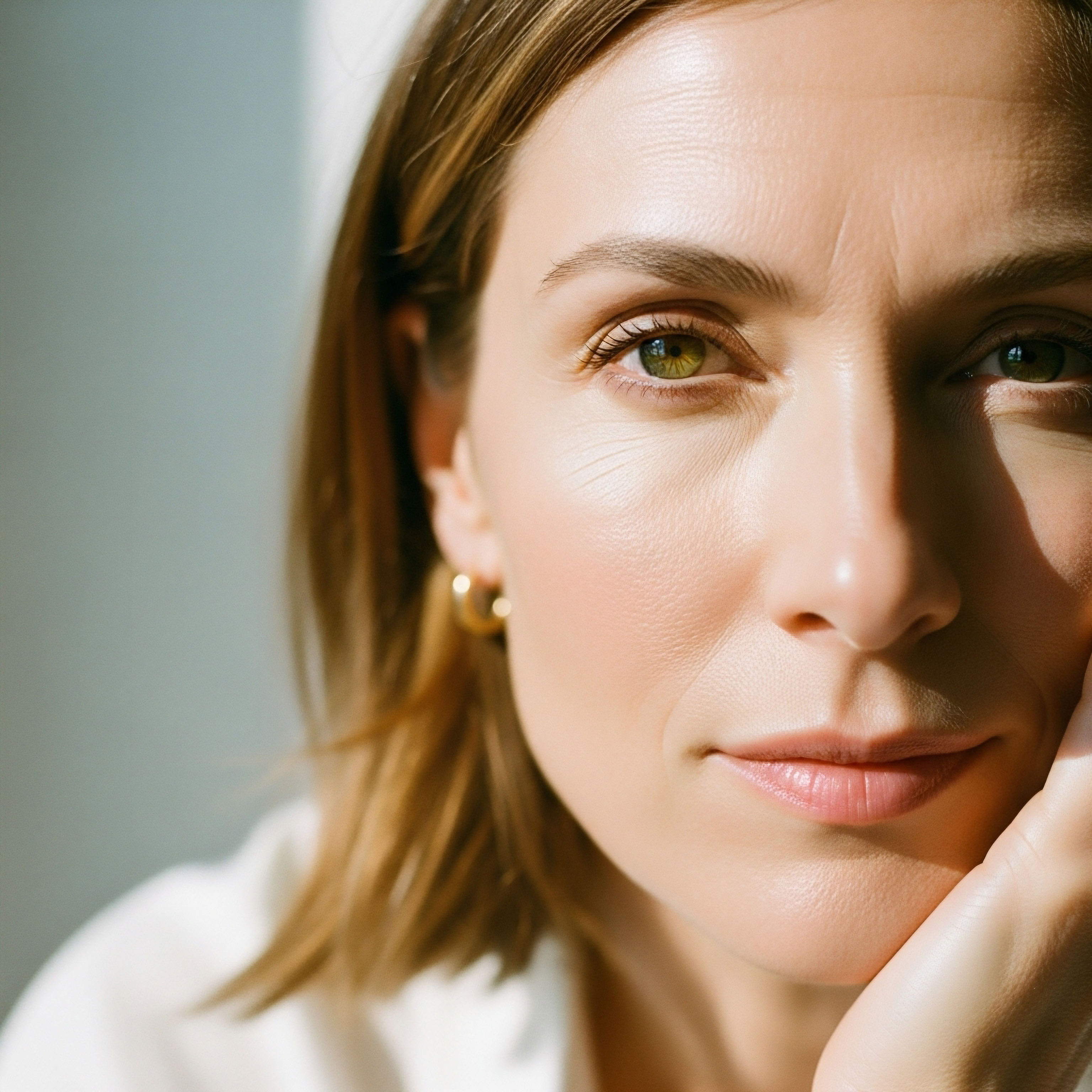

Fundamentals
Perhaps you have felt a subtle shift, a quiet diminishment of the vitality that once seemed boundless. It might manifest as a persistent fatigue that sleep cannot fully resolve, a fading enthusiasm for activities you once cherished, or a general sense that your body is simply not responding as it once did.
These experiences are not merely signs of aging; they often represent a deeper conversation occurring within your endocrine system, a complex network of glands and hormones that orchestrates nearly every biological process. Understanding these internal communications is the first step toward reclaiming your energetic self.
Many individuals experiencing these changes find themselves exploring options like Testosterone Replacement Therapy (TRT). This therapeutic approach aims to restore circulating testosterone levels to a physiological range, addressing symptoms associated with low testosterone, often termed hypogonadism.
While TRT can significantly improve quality of life, a common concern arises regarding its potential impact on natural testicular function, particularly the production of sperm and intrinsic testosterone. This is where the conversation often turns to Human Chorionic Gonadotropin (HCG), a compound frequently administered alongside TRT.
HCG administration with TRT aims to preserve testicular function and intrinsic hormone production.
HCG mimics the action of Luteinizing Hormone (LH), a crucial signaling molecule produced by the pituitary gland. LH typically stimulates the Leydig cells within the testes to synthesize testosterone. When exogenous testosterone is introduced via TRT, the body’s natural feedback loops often suppress LH and Follicle-Stimulating Hormone (FSH) production, leading to a reduction in testicular size and a decline in endogenous testosterone synthesis.
HCG intervenes in this process, providing an external stimulus to the Leydig cells, thereby helping to maintain testicular volume and intrinsic testosterone production. This co-administration strategy seeks to balance the benefits of exogenous testosterone with the preservation of natural endocrine function.

The Endocrine System and Its Orchestration
The endocrine system functions as the body’s internal messaging service, utilizing hormones as chemical messengers to regulate a vast array of physiological processes. This intricate network includes glands such as the pituitary, thyroid, adrenal glands, and gonads. Each hormone plays a specific role, yet they operate within a highly interconnected system, where the alteration of one hormonal pathway can influence many others.
Testosterone, for instance, is not solely a reproductive hormone; it exerts wide-ranging effects on muscle mass, bone density, mood, cognitive function, and cardiovascular health.
When considering hormonal optimization protocols, a comprehensive understanding of these interdependencies becomes paramount. The goal extends beyond simply addressing a single hormone deficiency; it involves recalibrating the entire system to support overall well-being. This holistic perspective acknowledges that symptoms are often reflections of systemic imbalances, not isolated issues.

Understanding Hypogonadism
Hypogonadism, a condition characterized by insufficient testosterone production, can stem from various causes, including primary testicular failure or secondary issues originating in the pituitary or hypothalamus. Symptoms can be diverse, ranging from reduced libido and erectile dysfunction to decreased energy, mood disturbances, and a decline in muscle strength. Recognizing these manifestations is the first step toward seeking appropriate clinical evaluation and potential therapeutic interventions.
Clinical assessment typically involves a thorough review of symptoms, a physical examination, and blood tests to measure hormone levels, including total and free testosterone, LH, and FSH. These diagnostic steps provide a clear picture of the underlying hormonal status, guiding the development of a personalized treatment plan.


Intermediate
The decision to pursue hormonal optimization protocols, particularly those involving Testosterone Replacement Therapy (TRT) and Human Chorionic Gonadotropin (HCG), requires a detailed understanding of their mechanisms and clinical applications. These interventions are not merely about symptom management; they represent a strategic recalibration of the body’s biochemical systems, aiming to restore physiological balance and enhance overall vitality. The long-term outcomes, especially concerning cardiovascular health, warrant careful consideration and a data-driven approach.

Clinical Protocols for Male Hormone Optimization
For men experiencing symptoms of low testosterone, a standard protocol often involves weekly intramuscular injections of Testosterone Cypionate (200mg/ml). This exogenous testosterone provides a consistent supply of the hormone, alleviating symptoms associated with its deficiency. However, the body’s natural feedback mechanisms, sensing the presence of external testosterone, reduce the production of Luteinizing Hormone (LH) and Follicle-Stimulating Hormone (FSH) from the pituitary gland. This suppression can lead to testicular atrophy and impaired spermatogenesis.
Integrating HCG with TRT helps preserve testicular size and natural testosterone production.
To counteract these effects, Human Chorionic Gonadotropin (HCG) is frequently co-administered, typically via subcutaneous injections twice weekly. HCG acts as an LH mimetic, directly stimulating the Leydig cells in the testes to produce testosterone and maintain testicular volume. This approach helps to preserve fertility potential and intrinsic testicular function, which is a significant consideration for many individuals.
Another important aspect of male hormone optimization involves managing estrogen levels. Testosterone can convert into estrogen through the enzyme aromatase. Elevated estrogen levels in men can lead to undesirable effects such as gynecomastia, water retention, and mood disturbances. To mitigate this, an aromatase inhibitor like Anastrozole is often prescribed, typically as an oral tablet twice weekly. This medication helps to block the conversion of testosterone to estrogen, maintaining a healthier hormonal balance.
In some cases, additional medications like Enclomiphene may be included to further support LH and FSH levels, particularly if fertility preservation is a primary concern or if the individual is transitioning off TRT. Enclomiphene selectively blocks estrogen receptors in the hypothalamus and pituitary, thereby disinhibiting LH and FSH release.

Protocols for Female Hormone Balance
Hormonal balance is equally critical for women, particularly during pre-menopausal, peri-menopausal, and post-menopausal phases. Symptoms such as irregular cycles, mood changes, hot flashes, and reduced libido often signal shifts in estrogen, progesterone, and testosterone levels.
For women, Testosterone Cypionate is typically administered in much lower doses, often 10 ∞ 20 units (0.1 ∞ 0.2ml) weekly via subcutaneous injection. This low-dose testosterone therapy can significantly improve energy, libido, and overall well-being without inducing virilizing effects. Progesterone is prescribed based on menopausal status, playing a crucial role in uterine health and symptom management, especially for women with an intact uterus.
Pellet therapy offers a long-acting alternative for testosterone administration, providing a steady release of the hormone over several months. When appropriate, Anastrozole may also be used in women to manage estrogen levels, particularly in cases where estrogen dominance is a concern or as part of specific therapeutic strategies.

Post-TRT and Fertility-Stimulating Protocols
For men who have discontinued TRT or are actively trying to conceive, a specific protocol is implemented to stimulate natural testosterone production and spermatogenesis. This protocol typically includes a combination of agents designed to reactivate the Hypothalamic-Pituitary-Gonadal (HPG) axis.
- Gonadorelin ∞ Administered via subcutaneous injections, Gonadorelin stimulates the release of LH and FSH from the pituitary gland, thereby signaling the testes to resume testosterone and sperm production.
- Tamoxifen ∞ This selective estrogen receptor modulator (SERM) blocks estrogen’s negative feedback on the pituitary, leading to increased LH and FSH secretion.
- Clomid (Clomiphene Citrate) ∞ Similar to Tamoxifen, Clomid also acts as a SERM, promoting the release of gonadotropins and stimulating testicular function.
- Anastrozole ∞ Optionally included to manage estrogen levels, preventing excessive estrogen conversion during the rebound of endogenous testosterone.

Growth Hormone Peptide Therapy
Beyond traditional hormone replacement, peptide therapies offer targeted support for various physiological functions, appealing to active adults and athletes seeking anti-aging benefits, muscle gain, fat loss, and improved sleep. These peptides work by stimulating the body’s natural production of growth hormone or by directly influencing specific pathways.
Key peptides in this category include ∞
- Sermorelin ∞ A growth hormone-releasing hormone (GHRH) analog that stimulates the pituitary to produce and secrete growth hormone.
- Ipamorelin / CJC-1295 ∞ A combination often used to provide a sustained, pulsatile release of growth hormone, promoting muscle repair and fat metabolism.
- Tesamorelin ∞ A GHRH analog specifically approved for reducing visceral fat in certain conditions.
- Hexarelin ∞ A growth hormone secretagogue that can also influence appetite and gastric motility.
- MK-677 (Ibutamoren) ∞ An oral growth hormone secretagogue that increases growth hormone and IGF-1 levels.

Other Targeted Peptides
The therapeutic utility of peptides extends to other areas of health ∞
- PT-141 (Bremelanotide) ∞ This peptide acts on melanocortin receptors in the brain to improve sexual function and desire in both men and women.
- Pentadeca Arginate (PDA) ∞ PDA is recognized for its role in tissue repair, accelerating healing processes, and modulating inflammatory responses.
These diverse protocols underscore a personalized approach to wellness, where specific biochemical needs are addressed with precision. The integration of HCG with TRT, for instance, represents a sophisticated strategy to mitigate potential side effects while maximizing therapeutic benefits.
| Protocol | Primary Target Audience | Key Therapeutic Agents | Main Objectives |
|---|---|---|---|
| TRT Men with HCG | Middle-aged to older men with low testosterone | Testosterone Cypionate, HCG, Anastrozole | Restore testosterone levels, preserve testicular function, manage estrogen |
| TRT Women | Pre/peri/post-menopausal women with symptoms | Testosterone Cypionate (low dose), Progesterone, Anastrozole (optional) | Improve libido, energy, mood; balance female hormones |
| Post-TRT / Fertility | Men discontinuing TRT or seeking conception | Gonadorelin, Tamoxifen, Clomid, Anastrozole (optional) | Reactivate natural testosterone production, stimulate spermatogenesis |
| Growth Hormone Peptides | Active adults, athletes seeking anti-aging, performance | Sermorelin, Ipamorelin/CJC-1295, Tesamorelin, Hexarelin, MK-677 | Enhance muscle gain, fat loss, sleep, recovery |


Academic
The long-term outcomes of Human Chorionic Gonadotropin (HCG) administration with Testosterone Replacement Therapy (TRT), particularly concerning cardiovascular health, represent a complex area of clinical inquiry. Understanding these outcomes necessitates a deep dive into the interplay of the endocrine system, metabolic pathways, and direct vascular effects. The scientific literature offers insights into how these hormonal interventions can influence cardiovascular markers and overall risk profiles.

Cardiovascular Health and Hormonal Balance
Testosterone plays a significant role in cardiovascular physiology. It influences endothelial function, lipid metabolism, glucose regulation, and inflammatory processes. Hypogonadism in men has been associated with an increased risk of cardiovascular disease, metabolic syndrome, and type 2 diabetes. Restoring physiological testosterone levels through TRT is often hypothesized to improve these markers, potentially mitigating cardiovascular risk. However, the precise mechanisms and long-term effects, especially when HCG is co-administered, require careful scrutiny.
Hormonal balance, particularly testosterone levels, significantly impacts cardiovascular physiology and metabolic health.
The cardiovascular system is not merely a pump and a network of pipes; it is a highly responsive organ system influenced by systemic signals, including hormones. Dysregulation within the endocrine system can manifest as changes in blood pressure, lipid profiles, and vascular elasticity, all of which contribute to cardiovascular risk.

The Role of HCG in the TRT Context
HCG’s primary function in the context of TRT is to maintain endogenous testicular function by mimicking Luteinizing Hormone (LH). This helps prevent testicular atrophy and preserves spermatogenesis, which are common side effects of TRT monotherapy due to suppression of the Hypothalamic-Pituitary-Gonadal (HPG) axis. From a cardiovascular perspective, the continued endogenous production of testosterone, even if supplemented by exogenous sources, might offer distinct advantages.
Some researchers hypothesize that maintaining a more physiological hormonal milieu, where the testes continue to produce a spectrum of androgens and their precursors, could be beneficial. The testes produce not only testosterone but also other androgens like dihydrotestosterone (DHT) and dehydroepiandrosterone (DHEA), as well as estrogen through local aromatization.
While exogenous TRT provides primarily testosterone, the addition of HCG ensures the continued activity of the Leydig cells, potentially maintaining a broader hormonal profile that might contribute to overall health, including cardiovascular well-being.

Investigating Cardiovascular Markers
Clinical studies examining the long-term cardiovascular outcomes of TRT, with or without HCG, often focus on several key markers ∞
- Lipid Profiles ∞ Changes in total cholesterol, LDL cholesterol, HDL cholesterol, and triglycerides. Some studies suggest TRT can have variable effects on lipids, with some showing improvements and others minimal change. The impact of HCG on these lipid changes is an area of ongoing investigation.
- Blood Pressure ∞ The influence on systolic and diastolic blood pressure. Hormonal fluctuations can affect vascular tone and fluid balance, directly impacting blood pressure regulation.
- Insulin Sensitivity and Glucose Metabolism ∞ Testosterone has been shown to improve insulin sensitivity in hypogonadal men. Maintaining endogenous testicular function with HCG might further support these metabolic benefits.
- Inflammatory Markers ∞ Levels of C-reactive protein (CRP) and other inflammatory cytokines. Chronic inflammation is a known contributor to cardiovascular disease.
- Endothelial Function ∞ The health and flexibility of blood vessel linings. Testosterone can influence nitric oxide production, a key vasodilator.
- Hematocrit and Hemoglobin ∞ TRT can increase red blood cell production, leading to elevated hematocrit. While this can improve oxygen-carrying capacity, excessively high hematocrit can increase blood viscosity and cardiovascular risk. HCG’s role in modulating this effect is an important consideration.

Clinical Trial Data and Observational Studies
Much of the current understanding regarding TRT and cardiovascular health comes from a combination of observational studies and randomized controlled trials. Early concerns about TRT increasing cardiovascular risk have largely been mitigated by more recent, robust research, which often suggests a neutral or even beneficial effect in appropriately selected hypogonadal men.
However, the specific long-term data on the combination of HCG and TRT, particularly concerning hard cardiovascular endpoints (e.g. myocardial infarction, stroke), remains less extensive than for TRT monotherapy.
Research indicates that maintaining physiological testosterone levels can improve metabolic parameters associated with cardiovascular health, such as insulin resistance and body composition. The addition of HCG, by preserving testicular function, may contribute to a more stable hormonal environment, potentially supporting these positive metabolic shifts. However, direct evidence specifically isolating HCG’s long-term cardiovascular impact in this combined therapy context is still accumulating.
One area of particular interest is the potential for HCG to influence the balance of various androgens and estrogens produced endogenously. While exogenous testosterone primarily provides testosterone, HCG stimulates the entire Leydig cell steroidogenesis pathway. This could lead to a more balanced production of other steroid hormones, which might collectively contribute to cardiovascular protection or risk. Further research is needed to fully elucidate these complex interactions.

What Are the Long-Term Cardiovascular Considerations with HCG and TRT?
The long-term cardiovascular considerations with HCG and TRT involve a careful balancing act. While TRT aims to alleviate symptoms of hypogonadism and potentially improve metabolic markers, the addition of HCG seeks to mitigate the suppressive effects on endogenous testicular function. The critical question centers on whether this preservation of natural testicular activity translates into a distinct long-term cardiovascular benefit or risk profile compared to TRT alone.
Some clinicians hypothesize that maintaining the integrity of the HPG axis through HCG co-administration could lead to a more stable and physiologically aligned hormonal environment, potentially offering a protective effect on the cardiovascular system. This is based on the premise that the testes produce a broader array of beneficial compounds beyond just testosterone, which might contribute to overall vascular health.
Conversely, any intervention that alters hormonal balance requires vigilant monitoring of cardiovascular risk factors. Regular assessment of lipid profiles, blood pressure, glucose metabolism, and hematocrit is essential for individuals undergoing TRT with HCG. The goal is to optimize hormonal levels while minimizing any potential adverse effects on the cardiovascular system.
| Cardiovascular Marker | Typical TRT Effect | Potential HCG Influence (with TRT) | Clinical Monitoring |
|---|---|---|---|
| Lipid Profile | Variable, often neutral or minor improvements | May contribute to a more stable lipid profile by preserving endogenous steroidogenesis | Annual lipid panel |
| Blood Pressure | Generally neutral, may improve in some hypogonadal men | Likely neutral, as direct effects on vascular tone are minimal | Regular blood pressure checks |
| Insulin Sensitivity | Improvements in insulin resistance | May enhance metabolic benefits by maintaining broader hormonal spectrum | HbA1c, fasting glucose |
| Hematocrit | Can increase, requiring monitoring for polycythemia | May slightly modulate, but primary effect is from exogenous testosterone | Complete blood count (CBC) every 3-6 months |
| Endothelial Function | Improvements in nitric oxide production | Potential for synergistic effects by supporting overall vascular health | Not routinely monitored, but a research interest |

How Does HCG Administration Influence Cardiovascular Risk Factors?
The influence of HCG administration on cardiovascular risk factors, when combined with TRT, is primarily indirect. HCG’s direct action is on the Leydig cells, stimulating their function. This stimulation leads to the endogenous production of testosterone and other testicular steroids. By maintaining this endogenous production, HCG helps to prevent the complete shutdown of the testes, which can occur with TRT monotherapy.
The hypothesis is that a more complete hormonal profile, including the continued production of DHEA and other precursors, might offer a more physiological and potentially beneficial impact on cardiovascular health compared to relying solely on exogenous testosterone. However, this remains an area of active research. The overall cardiovascular outcome is likely a summation of the effects of exogenous testosterone, the preserved endogenous testicular function, and the individual’s baseline health status.

Are There Specific Cardiovascular Biomarkers Affected by HCG Co-Administration?
Specific cardiovascular biomarkers affected by HCG co-administration are largely those influenced by overall androgen and estrogen balance. While HCG itself does not directly alter cardiovascular markers in the same way a statin would, its role in maintaining endogenous testicular function means it influences the substrate for downstream hormonal conversions. For example, if HCG helps maintain a healthier balance of androgens and estrogens, this could indirectly influence lipid profiles, glucose metabolism, and inflammatory markers.
The primary biomarker directly affected by HCG is LH, which it mimics, and consequently, endogenous testosterone production. Any downstream cardiovascular effects are secondary to these hormonal shifts. Clinical monitoring focuses on the overall picture of cardiovascular health, considering all aspects of the patient’s hormonal and metabolic profile.

References
- Bhasin, Shalender, et al. “Testosterone Therapy in Men With Hypogonadism ∞ An Endocrine Society Clinical Practice Guideline.” Journal of Clinical Endocrinology & Metabolism, vol. 103, no. 5, 2018, pp. 1715 ∞ 1744.
- Boron, Walter F. and Emile L. Boulpaep. Medical Physiology. 3rd ed. Elsevier, 2017.
- Guyton, Arthur C. and John E. Hall. Textbook of Medical Physiology. 14th ed. Elsevier, 2020.
- Kovac, Jason R. et al. “The Effects of Testosterone Supplementation on Cardiovascular Risk Factors in Men.” Translational Andrology and Urology, vol. 4, no. 2, 2015, pp. 177 ∞ 185.
- Morgentaler, Abraham. Testosterone for Life ∞ Recharge Your Sex Drive, Muscle Mass, Energy, and Mood. Rodale Books, 2008.
- Rhoden, Ernani Luis, and Ricardo Telöken. “Testosterone Replacement Therapy and Cardiovascular Risk ∞ A Critical Review.” Current Opinion in Urology, vol. 26, no. 2, 2016, pp. 162 ∞ 168.
- Shabsigh, Ridwan, et al. “Testosterone Therapy in Men with Hypogonadism and Metabolic Syndrome ∞ A Systematic Review.” Journal of Sexual Medicine, vol. 11, no. 10, 2014, pp. 2601 ∞ 2612.
- Traish, Abdulmaged M. et al. “Testosterone and the Cardiovascular System ∞ A Comprehensive Review.” Journal of the American Heart Association, vol. 5, no. 11, 2016, e002811.

Reflection
Your personal health journey is a dynamic process, a continuous dialogue between your body’s innate wisdom and the insights gained from clinical science. Understanding the intricate connections within your endocrine system, particularly how interventions like Human Chorionic Gonadotropin (HCG) and Testosterone Replacement Therapy (TRT) interact, represents a significant step toward self-agency.
This knowledge is not merely academic; it is a tool for informed decision-making, allowing you to partner with your healthcare provider to design protocols that truly align with your physiological needs and long-term wellness aspirations.
Consider this exploration a foundational piece in your ongoing commitment to vitality. The goal is always to move beyond simply managing symptoms, instead seeking to restore the underlying biological harmony that supports robust health. This path requires patience, consistent monitoring, and a willingness to adapt as your body responds. Your unique biological systems hold the key to reclaiming optimal function, and every piece of knowledge gained brings you closer to that potential.



